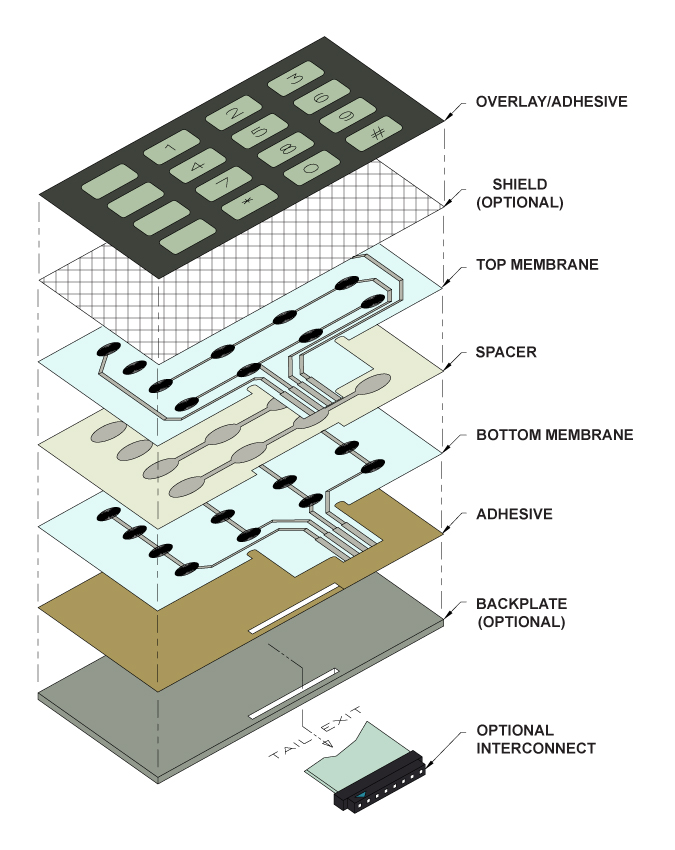Membrane Switches vs. Mechanical Switches: What You Need to Understand
Membrane Switches vs. Mechanical Switches: What You Need to Understand
Blog Article
Why Membrane Layer Switches Over Are Essential for Resilient Control Systems
Membrane switches play a pivotal duty in making sure the longevity and integrity of control systems throughout different sectors. As we check out the multifaceted benefits of membrane switches, it becomes apparent that their value goes beyond mere functionality, affecting individual experience and functional effectiveness.
Summary of Membrane Switches
Membrane layer buttons are versatile and reputable components generally utilized in various digital control systems. The visuals overlay provides both practical and visual layout, while the spacer layer makes certain that the switches are triggered just when pushed.
Membrane switches are usually preferred in applications requiring a compact and light-weight style, making them excellent for portable devices, clinical tools, and industrial equipment. They can be personalized to satisfy certain customer requirements and can integrate various attributes such as backlighting, tactile comments, and several shades. Membrane layer switches are immune to dust, wetness, and contaminants, making them ideal for atmospheres where longevity is crucial.
Advantages of Resilience
In several applications, the durability of membrane layer switches over deals considerable benefits that enhance their general performance and dependability. These buttons are made to stand up to rough atmospheres, making them excellent for use sought after conditions such as high moisture, extreme temperatures, and direct exposure to chemicals. Their durable building and construction helps to stop damages from physical impact, guaranteeing lasting functionality and minimizing the demand for constant substitutes.
Furthermore, membrane layer switches are immune to deterioration, which is essential in applications where constant communication takes place. This sturdiness translates to decrease upkeep costs, as organizations gain from minimized downtime and fewer service interruptions. Additionally, the encapsulated design of membrane layer changes shields internal parts from dust and moisture access, further adding to their lifespan.
Another advantage is their ability to keep constant performance with time. With a high tolerance for mechanical stress, these buttons maintain their tactile feedback and electric stability, ensuring user fulfillment. Ultimately, the resilience of membrane layer switches over not only improves functional performance yet also promotes self-confidence in their reliability, making them a favored selection for control systems across different industries.
Applications in Numerous Industries
Durable control systems utilizing membrane switches discover substantial applications throughout a variety of sectors, each taking advantage of the distinct qualities these buttons supply. In the clinical field, membrane buttons are important for gadgets such as client monitors and diagnostic devices, where dependability and ease of cleaning are paramount. Their resistance to dampness and contaminants guarantees they preserve performance in sterile settings.
The vehicle industry leverages membrane layer buttons for control panel controls and infotainment systems, where they offer sleek, inconspicuous user interfaces that enhance customer experience. These buttons are likewise developed to stand up to browse around this web-site harsh conditions, consisting of direct exposure to extreme temperatures and vibrations.
In industrial settings, membrane switches are typically made use of in machinery control board, offering responsive comments and resilience essential for high-usage applications. Their ability to stand up to chemicals makes them appropriate for producing environments where spills and impurities are frequent.

Customer electronics, such as cooking area devices and remote controls, also utilize membrane layer switches for their convenience and cost-effectiveness. Overall, the adaptability and robust nature of membrane switches over make them crucial throughout numerous sectors, making certain effective procedure and durability in control systems.
Style and Aesthetic Appeal
While performance is extremely important, the style and visual appeal of control systems equipped with membrane buttons play an important duty in customer interaction and overall experience (membrane switch). The aesthetic layout of these buttons can considerably affect customer assumption and interaction. A well-designed membrane layer switch enhances the appearance of the gadget, making it a lot more appealing to users and promoting a connection between the customer and the product
Membrane switches offer a terrific bargain of adaptability in style, allowing manufacturers to tailor graphics, shades, and structures to line up with brand identification and item aesthetics. The use of vivid colors and distinct patterns can draw focus, while tactile comments can enhance the user's interaction with the device. In addition, the ability to integrate LED indications and backlighting right into the membrane switch design offers both practical and visual benefits, enhancing exposure and functionality in numerous sites environments.

Enhancing Customer Experience

In addition, membrane layer switches can be personalized to integrate graphical user interfaces, enhancing usability by offering info in a clear and user-friendly manner (membrane switch). This modification can include symbols, tags, and color coding that guide customers via complex performances with simplicity. Furthermore, their versatility allows for assimilation in various atmospheres, making sure regular performance whether in industrial machinery or customer electronic devices
The toughness of membrane switches additionally plays a vital function in customer experience. By holding up against harsh problems and extended use, these switches reduce the likelihood of system failings, thus promoting reliability and individual confidence. Inevitably, the critical use membrane switches not just raises functionality but likewise significantly improves user communication with control systems, making them a crucial element in modern-day style.
Verdict

Report this page